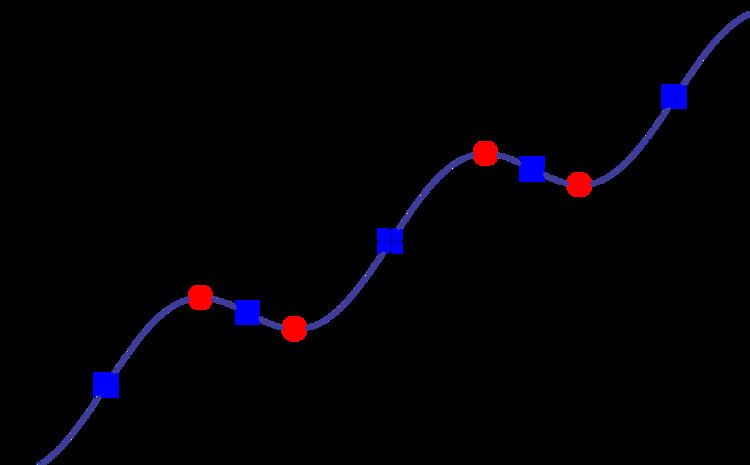 | ||
In mathematics, particularly in calculus, a stationary point or critical point of a differentiable function of one variable is a point of the domain of the function where the derivative is zero (equivalently, the slope of the graph at that point is zero). Informally, it is a point where the function "stops" increasing or decreasing (hence the name).
Contents
For a differentiable function of several real variables, a stationary (critical) point is an input (one value for each variable) where all its partial derivatives are zero (equivalently, the gradient is zero).
Stationary points are easy to visualize on the graph of a function of one variable: they correspond to the points on the graph where the tangent is horizontal (i.e., parallel to the x-axis). For a function of two variables, they correspond to the points on the graph where the tangent plane is parallel to the xy plane.
Stationary points, critical points and turning points
The term stationary point of a function may be confused with critical point for a given projection of the graph of the function.
"Critical point" is more general: a stationary point of a function corresponds to a critical point of its graph for the projection parallel to the x-axis. On the other hand, the critical points of the graph for the projection parallel to the y axis are the points where the derivative is not defined (more exactly tends to the infinity). It follows that some authors call "critical point" the critical points for any of these projections.
A turning point is a point at which the derivative changes sign. A turning point may be either a relative maximum or a relative minimum (also known as local minimum and maximum). If the function is differentiable, then a turning point is a stationary point; however not all stationary points are turning points. If the function is twice differentiable, the stationary points that are not turning points are horizontal inflection points. For example, the function
Classification
Isolated stationary points of a
The first two options are collectively known as "local extrema". Similarly a point that is either a global (or absolute) maximum or a global (or absolute) minimum is called a global (or absolute) extremum. The last two options—stationary points that are not local extremum—are known as saddle points.
By Fermat's theorem, global extrema must occur (for a
Curve sketching
Determining the position and nature of stationary points aids in curve sketching of differentiable functions. Solving the equation f'(x) = 0 returns the x-coordinates of all stationary points; the y-coordinates are trivially the function values at those x-coordinates. The specific nature of a stationary point at x can in some cases be determined by examining the second derivative f''(x):
A more straightforward way of determining the nature of a stationary point is by examining the function values between the stationary points (if the function is defined and continuous between them).
A simple example of a point of inflection is the function f(x) = x3. There is a clear change of concavity about the point x = 0, and we can prove this by means of calculus. The second derivative of f is the everywhere-continuous 6x, and at x = 0, f′′ = 0, and the sign changes about this point. So x = 0 is a point of inflection.
More generally, the stationary points of a real valued function
Example
For the function f(x) = x4 we have f'(0) = 0 and f''(0) = 0. Even though f''(0) = 0, this point is not a point of inflection. The reason is that the sign of f'(x) changes from negative to positive.
For the function f(x) = sin(x) we have f'(0) ≠ 0 and f''(0) = 0. But this is not a stationary point, rather it is a point of inflection. This is because the concavity changes from concave downwards to concave upwards and the sign of f'(x) does not change; it stays positive.
For the function f(x) = x3 we have f'(0) = 0 and f''(0) = 0. This is both a stationary point and a point of inflection. This is because the concavity changes from concave downwards to concave upwards and the sign of f'(x) does not change; it stays positive.
